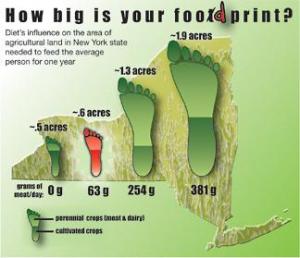
The number of people that our planet supports is growing fast [later edit: 7th billion baby comes with a warning], and for the diet that every man has there is a land surface which provides his food. Some types of diet require more land, some less; a low-fat vegetarian diet is very efficient and it does not need a big surface to provide the nutrients – this is nothing new.
But adding some dairy products and a limited amount of meat may actually increase this efficiency, Cornell researchers suggest.This was pointed out by a study which concludes that if everyone in New York state followed a low-fat vegetarian diet, the state could directly support almost 50 percent more people, or about 32 percent of its population, agriculturally. With the current diet which is very high-meat and high-dairy the state is able to support directly only 22 percent of its population.
This study is very important because it is the first study to to examine the land requirements of diets. They looked at 42 diets with the same number of calories and a core of grains, fruits, vegetables and dairy products with foods which are produced in New York state and found a fivefold difference between the two extremes.
“A person following a low-fat vegetarian diet, for example, will need less than half (0.44) an acre per person per year to produce their food,” said Christian Peters, M.S. ’02, Ph.D. ’07, a Cornell postdoctoral associate in crop and soil sciences and lead author of the research. “A high-fat diet with a lot of meat, on the other hand, needs 2.11 acres.”. “Surprisingly, however, a vegetarian diet is not necessarily the most efficient in terms of land use,” said Peters. That is because fruits vegetables and grains must be grown on high-quality cropland, he explained.
There are not so many crops. Meat and dairy products are supported by lower quality, but more widely available, land. “In order to reach the efficiency in land use of moderate-fat, vegetarian diets, our study suggests that New Yorkers would need to limit their annual meat and egg intake to about 2 cooked ounces a day,” Peters said. The average American ate approximately 5.8 ounces of meat and eggs a day in 2005.
Was this helpful?



